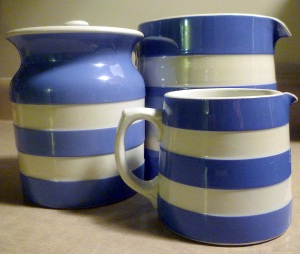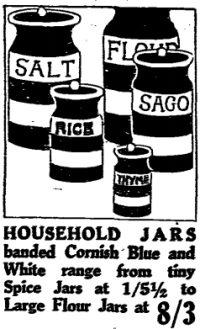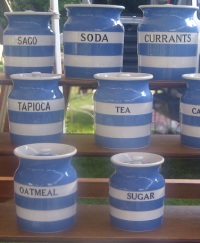
Why did Cornishware appeal to people in its early days? Now we think of it as a British “design classic”, collected above all for its distinctive broad blue and white stripes, the core pattern of the original TG Green Cornish Kitchen Ware range. Some collectors also like less common variations: black stripes, or a storage jar lettered with the name of a retro cooking ingredient.
The blue and white banding has always been the most popular design. Did it really suggest white-crested waves under a blue sky to its early customers, as the company now believes? Cornish seascapes inspired the brand name, but people often associated it more with cottage and farm kitchens than with the wide open sea.

The term Cornish was a marketing strategy used to evoke farmhouse and country associations, while the use of blue reinforced the fresh feel of the dairy.
Catherine McDermott, Design Museum Book of Twentieth Century Design, 1999
In 1932 the Manchester Guardian wrote about “Cornish farmhouse-ware, with its bold blue lines and white background”. A few years later one of its writers said you might get some at a “cottage sale” or “the village store”.
Cornishware was available in Canada in its early years, and there too it seemed like homey kind of stuff. When a new batch arrived in British Columbia after the second world war, an ad in the Vancouver Sun called it “lovely wholesome famous blue and white ware”.
In 1957 a New York store offered “peasant-type Cornishware earthenware, cherished for its rugged good looks.” It still had a pleasantly down-to-earth image for a New Yorker writer twenty years later:
… nice English Cornishware whose wide blue and off-white horizontal stripes have such an air of cheerful comfortableness …

Was it always intended to have a folksy appeal, for people wanting to make their kitchen or breakfast table look cosy and rural? Maybe not. The colour was originally called electric blue, or “e blue”, which sounds more contemporary than rustic. And Catherine McDermott, professor of design, links the style to Modernism as well as to farmhouses and dairies:
Cornishware’s distinctive blue and white bands owe something to the Continental development of well- designed, mass-produced Modernist tableware at this time.

So how do you react? Does Cornishware make you think of ocean waves, wholesome farm kitchens, or modernist electric blue?
Note
I haven’t tried to distinguish between genuine TG Green Cornishware and imitations here, with the main focus on discussing the way people feel about the Cornish Blue style.
One 1930 ad offered a Cornish Ware tangerine-and-white version which I haven’t come across elsewhere. Orange was available at some point, but was it made by TG Green in 1930?
Cornish Ware
…It’s available now in green-and-white or tangerine-and-white, as well as in the blue-and-white that everybody likes. The whole range is reduced for this event – plates, basins, store-jars, everything, as an example, you can have a sturdy two-pint milk jug for 2/9
Ad for Lewis’s Household Bargains Event, Feb 1930, Manchester Guardian
Photos
Photographers credited in captions. Links to originals and/or licenses: Jugs and jar, plates and butter dish, storage jars, or see more picture info here.
Hi there, great read. I was having a quick research online as I have just found a Cornish Marmalade jar in our cupboard! I thought it looked rather old!
LikeLike
Where can I buy this set please
LikeLike
Sarah, you can buy new Cornish Ware from T G Green at http://www.cornishware.com
LikeLike
I grew fond of seeing them on British TV series. Would love to buy them
LikeLike
Mary, you can buy new Cornish Ware from T G Green at http://www.cornishware.com
LikeLike
There is a site on Facebook with tons of information-T G Green(Pottery)Collectors group
LikeLike
The Archive Museum based at the pottery is now online and provides an informative database of all the patterns by T G Green as well as news of the rarest Cornish Ware jars and advertising features of the time.
LikeLike
I have noticed that your blog needs some fresh content.
Writing manually takes a lot of time, but there is tool for this
boring task, search for: unlimited content Wrastain’s tools
LikeLike